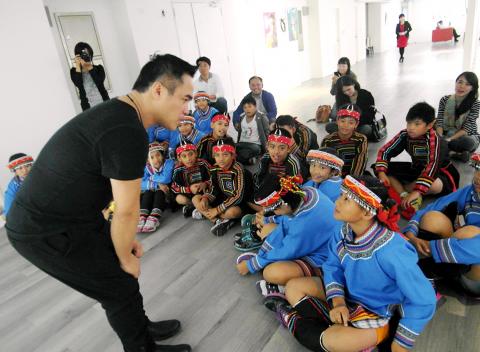Yosifu, a fine arts painter and Amis Aborigine, has just completed an art workshop for some of Taitung’s Aboriginal youth.
“I came back [to Taiwan] and did it because I wanted to give back to my people and help other indigenous artists develop,” he told the Taipei Times.
Yosifu, who lives in Edinburgh, promotes Taiwan’s indigenous culture throughout Europe.

Photo courtesy of the Taiwan Cultural & Creative Platform Foundation
As one of the first Taiwanese Aborigines to achieve international artistic success and recognition, he typifies the need for involvement at the grassroots level.
The Council of Indigenous Peoples and government agencies can set policies and hold conferences such as the recent 2013 International Austronesian Conference, but the level, extent and degree to which policies and actions are carried out often depends more on people at the grassroots level. Fortunately, in Taiwan that level is increasing.
There’s no one event or phenomenon that triggered this recent grassroots surge of involvement, though the increased use and ability of Facebook, YouTube and other social media may be a factor. In addition, art is a common denominator in many of the new grassroots projects.
Elise Tseng (曾珮貞) left a career in the art industry in 2011 to take charge of the Taiwan Cultural & Creative Platform Foundation.
“I saw that despite Taiwan having many artists, [art] had not yet touched and explored its basic base, namely its indigenous people,” Tseng said.
Her foundation sponsors workshops such as the one held by Yosifu. After researching Australian models of promoting indigenous culture, Tseng and the foundation used them to organize art and festivals.
“We strive to show [Aborigines the] environment of the urban city that they will face as artists and [encourage them] to dream big.” Dream Big is in fact the title of one of their projects.
A different unique story is that of American Tony Coolidge, who discovered his Atayal heritage when living in the US. This led to his involvement with indigenous peoples and the founding of Atayal, a nonprofit organization that tries to bring together indigenous cultures from around the world. His award-winning film Voices in the Clouds premiered in 2010.
“It was my personal roots trip back to my heritage,” Coolidge said.
Earlier this month, Coolidge spearheaded a project called Tap Root, a Journey of Self-Discovery, in which Maori film students from New Zealand toured Taiwan and shared their Austronesian culture and experiences. This is not without some irony since they arrived during the 2013 International Austronesian Conference but were not acknowledged by it.
Kolas Yotaka, a producer and presenter at Taiwan Indigenous TV, says that art is not the only platform for involvement. Some groups focus on political issues — Yotaka named the Taiwan Indigenous Tribal Movement League (台灣部落行動聯盟) led by Omi Wilang of the Taiwan Presbyterian Church, and the Smoke Signals League.
“But even with the political, art can take a supportive role,” Yotaka said.
Art and culture certainly seem to be the vehicle that allows all to get involved.
Minna Hsu (徐敏娜), a Taiwanese American working on a Ph.D in Human Geography at Macquarie University in Sydney, Australia, decided to join the newly formed Austronesian Cultural and Economic Cooperative Association because she believes that it is important to “promote awareness of and cooperation between the indigenous cultures of Taiwan and abroad.”
Taiwan’s expat community is also finding art to be a less threatening environment for involvement. Jonathan Burke, a director in the customer service field, is a permanent resident in Taiwan who has long been involved in volunteer work.
“It is an expression of my Christian faith to assist and help socially marginalized groups.”
In 2011, he started participating in photography workshops that help Aboriginal youth expand their artistic expression.
Yosifu says government assistance is important, but that the grassroots may be where it’s at, and that art is proving to be the medium.
“I came to find a sense of pride and acceptance in Europe first by trying modern art. Success there led me to realize I should also be proud of my indigenous heritage and incorporate that into my art. I even took back my tribal name, Yosifu. Now I return regularly to help others,” he said.

The Taipei Times last week reported that the rising share of seniors in the population is reshaping the nation’s housing markets. According to data from the Ministry of the Interior, about 850,000 residences were occupied by elderly people in the first quarter, including 655,000 that housed only one resident. H&B Realty chief researcher Jessica Hsu (徐佳馨), quoted in the article, said that there is rising demand for elderly-friendly housing, including units with elevators, barrier-free layouts and proximity to healthcare services. Hsu and others cited in the article highlighted the changing family residential dynamics, as children no longer live with parents,

It is jarring how differently Taiwan’s politics is portrayed in the international press compared to the local Chinese-language press. Viewed from abroad, Taiwan is seen as a geopolitical hotspot, or “The Most Dangerous Place on Earth,” as the Economist once blazoned across their cover. Meanwhile, tasked with facing down those existential threats, Taiwan’s leaders are dying their hair pink. These include former president Tsai Ing-wen (蔡英文), Vice President Hsiao Bi-khim (蕭美琴) and Kaohsiung Mayor Chen Chi-mai (陳其邁), among others. They are demonstrating what big fans they are of South Korean K-pop sensations Blackpink ahead of their concerts this weekend in Kaohsiung.

Oct 20 to Oct 26 After a day of fighting, the Japanese Army’s Second Division was resting when a curious delegation of two Scotsmen and 19 Taiwanese approached their camp. It was Oct. 20, 1895, and the troops had reached Taiye Village (太爺庄) in today’s Hunei District (湖內), Kaohsiung, just 10km away from their final target of Tainan. Led by Presbyterian missionaries Thomas Barclay and Duncan Ferguson, the group informed the Japanese that resistance leader Liu Yung-fu (劉永福) had fled to China the previous night, leaving his Black Flag Army fighters behind and the city in chaos. On behalf of the

I was 10 when I read an article in the local paper about the Air Guitar World Championships, which take place every year in my home town of Oulu, Finland. My parents had helped out at the very first contest back in 1996 — my mum gave out fliers, my dad sorted the music. Since then, national championships have been held all across the world, with the winners assembling in Oulu every summer. At the time, I asked my parents if I could compete. At first they were hesitant; the event was in a bar, and there would be a lot